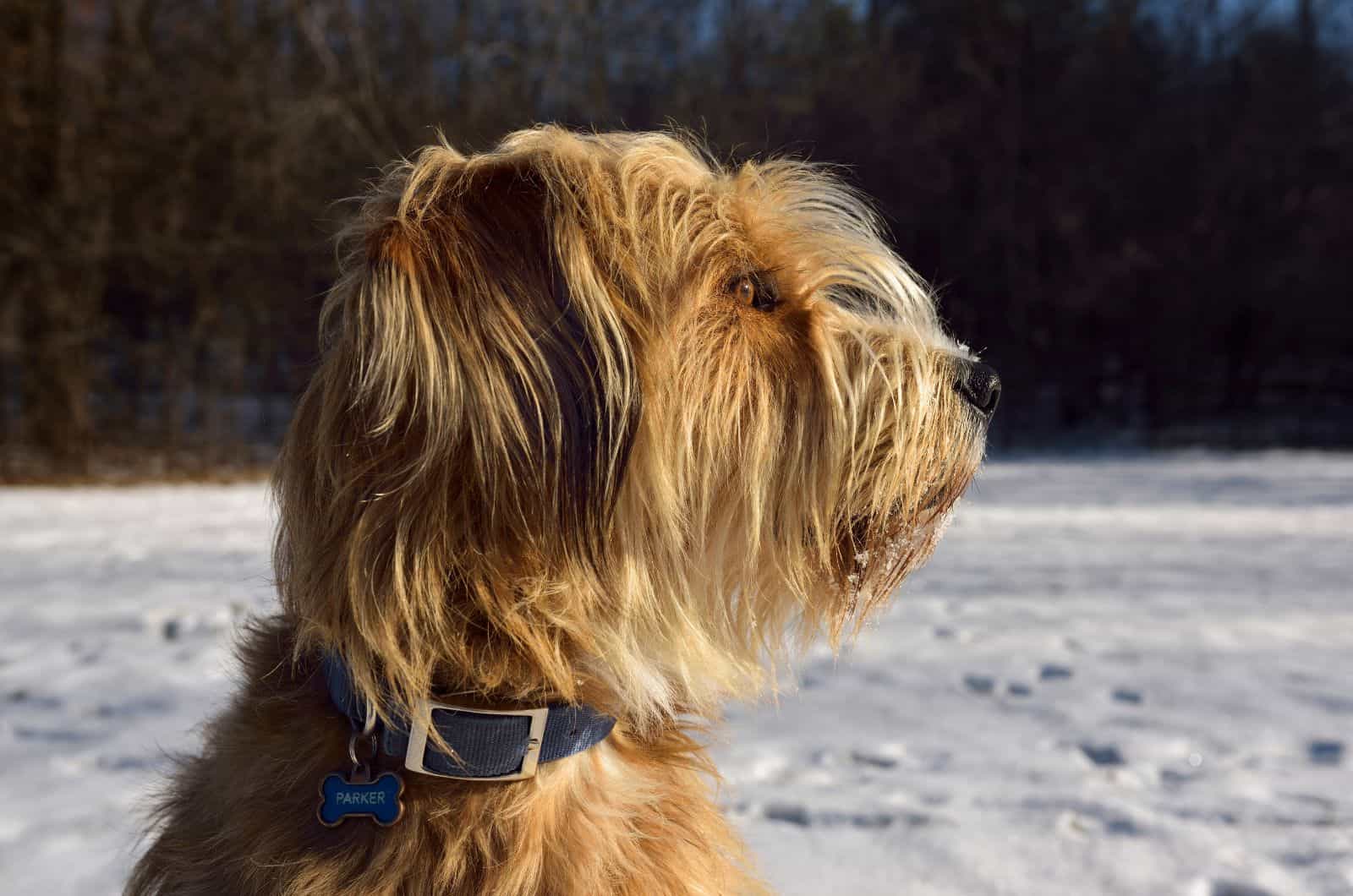How does a designer dog that is designed to be an intelligent watchdog sound to you? Pretty amazing, right? If yes, you should definitely explore this dog breed a bit more.
Having a dog that is of a medium to large size is definitely a plus if you are a person who likes sport and sport related activities, or if you simply want a dog that can guard you and your property.
Dog lovers often opt for bigger dog breeds, because of the many advantages that come with owning one of them.
In this article, we will go through all of the important information about this crossbreed. From its parent breed’s origins, to the origin of the Poodle mix itself, all the way to the details about how the dog breed looks, behaves, and is health-wise.
Let’s continue the learning process together!
What Is The Great Pyrenees Poodle Mix?
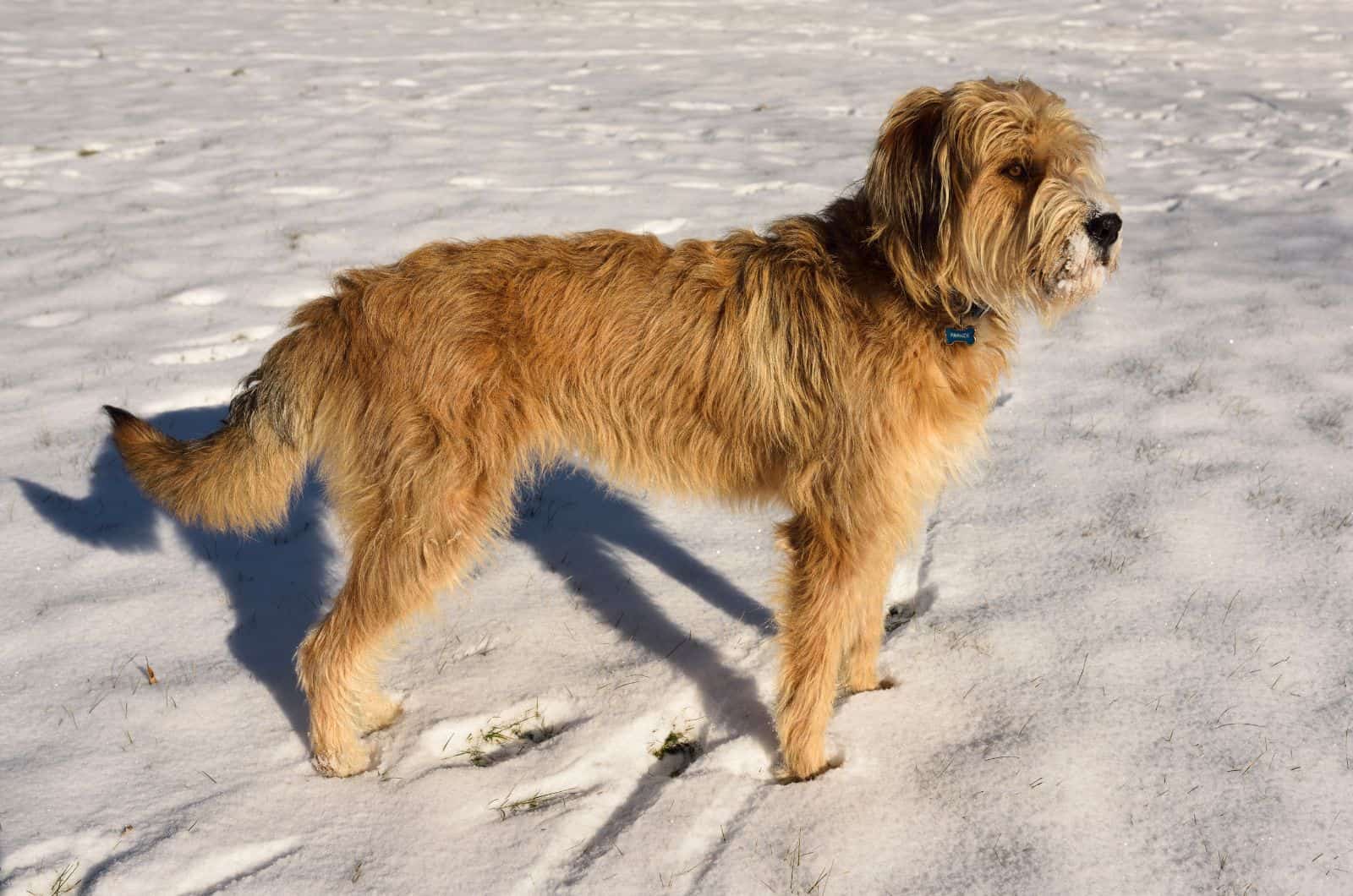
Crossbreed dogs have become a very common thing nowadays to the extent that crossbreed dogs seem to be appearing everywhere.
People have thought to themselves something like ‘Why should I settle for a dog breed that doesn’t have all of the characteristics that I want my dog to have?’ And by doing so, decided to make their own perfect, designer dog.
In short, we can say that the Great Pyrenees Poodle mix is a crossbreed, or a designer dog, created from two purebred, famous dog breeds.
Since both parent breeds are large dogs, which we will talk about a bit later, they have together made a beautiful gentle giant that people just love.
Origin Of The Pyredoodle

Photo from: @pyredoodle
None of the crossbreed dog breeds have an exact date when they officially started being bred. That is because many dog breeds, which have for example become stray dogs or which have bred without the owner’s intentions, will have mated God knows when and how.
That is why none of the crossbreeds have the exact date when they started populating more and more. However, this large dog breed’s origin can actually be somewhat traced!
The great experimentation with Poodle mixes became wildly popular around the 80s and 90s, when dog breed breeders started to experiment with this hypoallergenic dog breed, in order to create some other hypoallergenic dogs.
That is why, we can say that this dog breed probably first made an appearance around the 1990s, when breeders started experimenting with poodle mixes more widely.
Origin Of The Standard Poodle
According to the majority of cynologists, the Standard Poodle variation of today’s Poodle was first domesticated in Germany. As with England’s English Water Spaniel, France’s Barbet, Ireland’s Irish Water Spaniel, and the Netherlands’ Wetterhound, it is said that it was well-known in Germany as early as the Middle Ages and served as that country’s water dog.
The fact that the name Poodle, or “Pudel” in German, comes from the Low German term “puddeln” which means “to splash”, is among the evidence offered to support this theory.
Additionally, there are numerous artworks of recognizable Poodle-type dogs that date back to the late 17th/ early 18th century and were created by various German dog breeders.
Some experts believe that the Poodle’s origins go all the way back to France, but very likely, the Poodle’s origin is German.
The Poodle comes in a few size variations, which are: the Toy Poodle, the Miniature Poodle, the Standard Poodle, and the Large Poodle. The Poodle is known to be a highly intelligent dog, being in the top 3 most intelligent dog breeds on the planet.
This dog breed comes in various Poodle colors, ranging from solid to two-colored versions, among which the most popular are white, apricot, black, and chocolate-colored.
Read Also: Does The Giant Poodle Qualify As A Breed?
Origin Of The Great Pyrenees (Pyrenean Mountain Dog)
Among the Pyrenees’ traditional breeds is the Pyrenean Mountain Dog. It is commonly referred to as the “Patou” in France.
It is frequently asserted that it is linked to the Maremmano-Abruzzese Dog from Italy and also Kuvasz of Hungary because its ancestors, along with those of the Pyrenean Mastiff, were white cattle watch dogs introduced to the region from Asia during the Roman era. According to genomic information, it belongs to the same genetic lineage as the Ibizan Hound, Cirneco dell’Etna, as well as the Pharaoh Hound.
A dog of this kind was brought to the court of King Louis XIV in the seventeenth century by Madame de Maintenon and Louis, Dauphin of France. The dog quickly gained popularity in the court and was given the title “Royal Dog of France” by the King.
They were used by the French royalty, to guard their castles in provinces. Some dog experts say that these dogs were brought by French men to the area of Canada and that they are the parent breed of the Newfoundland dog.
The Great Pyrenees is a large dog breed, with inborn herding instincts. They are the perfect example of a gentle giant type of dog breed, since size can be sometimes unintentionally linked to some unwanted attributes. However, these dogs are huge sweethearts.
They usually come in a solid white variant, however, they may have some markings of colors such as tan, gray, light red and badger. There aren’t a huge variety of Great Pyrenees Colors since this dog breed is mostly white in color.
What Are Some Other Names For Pyredoodles?
Since combining the names of the parent breeds, aka the Great Pyrenees (The Great Pyrenees Mountain dog) and the Poodle creates a mouthful, the Great Pyrenees Poodle mix,, their crossbreed goes by a few different names.
Some of the other names for this dog breed, besides the Great Pyrenees Poodle mix, are Pyredoodle, Pyrepoo, Pyreneespoo, Pyredoo and Pyreneesdoodle.
Poo-doo and Poodle Pie, are some of the more informal ways that the owners nickname their Pyredoodles.
What Does The Pyredoodle Dog Look Like?
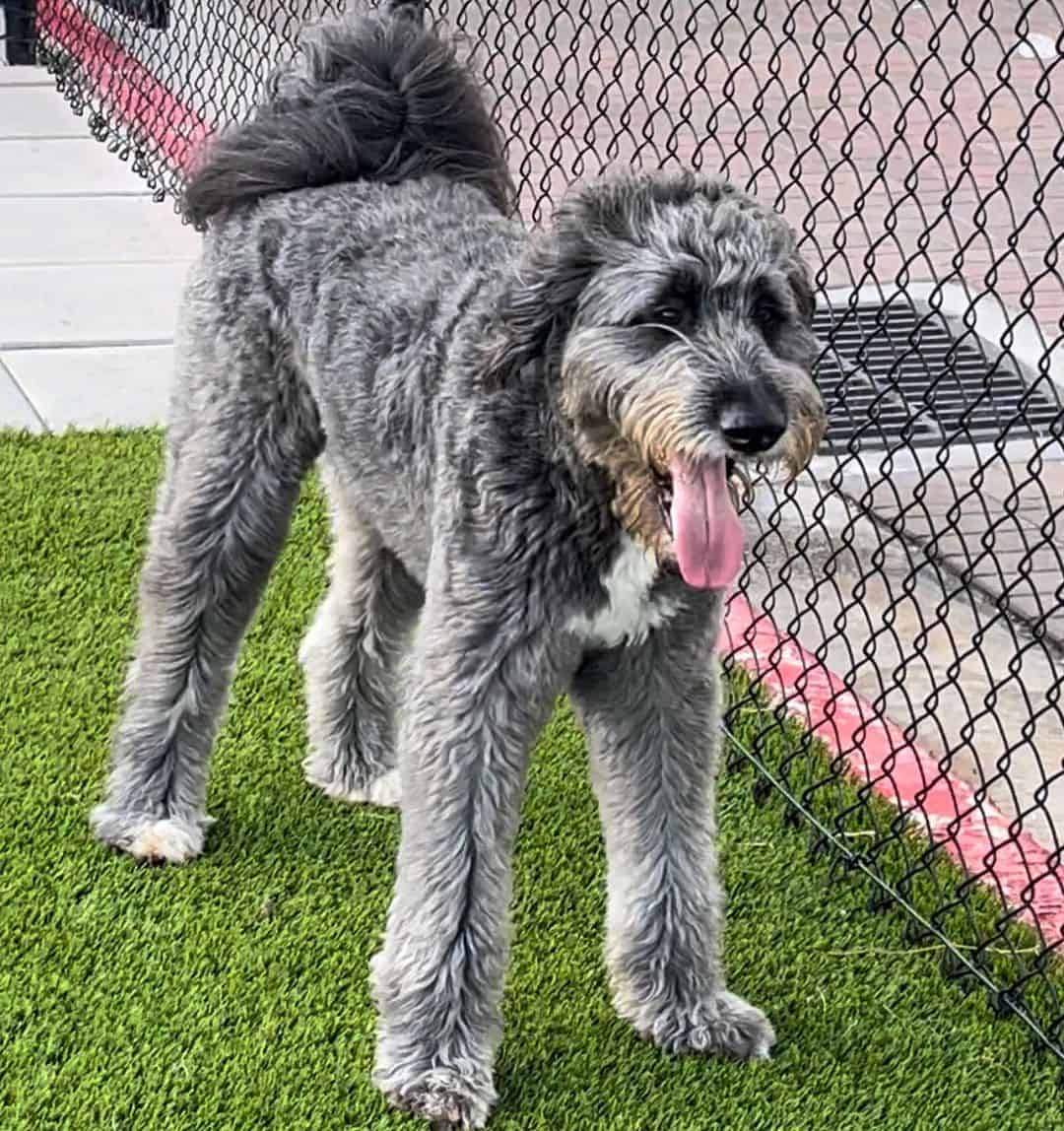
Photo from: @wolfeprincee
The Pyredoodle puppy just looks like a cute ball of fur. However, depending on the dominant genes of the purebred parent, the pyredoodle puppy can have some differences in terms of their outward appearance.
While some of their features can vary, this dog breed always has the distinctive doodle looks. They have that long muzzle characteristic of the poodle dog breed, and the triangle shaped ears that bend half-way and fall down towards the end of their head.
They have round eyes that are mostly hazel or dark brown to black in color. However, there can often be some variations regarding the eye color, where eyes can be green or yellow colored. However, they are not usually among the blue-eyed dog breeds.
The Pyredoodle dog is considered a large dog breed, since the Great Pyrenees dog is a large dog breed, and the Poodle is medium to large in size.
However, if you decide to breed a mini-Pyrenees with a mini-Poodle, you can potentially get a smaller dog breed. Just as Goldendoodles have size variations, this designer breed can potentially have them, too.
The thing that is most prominent in this dog breed is the dog’s coat. They have a really thick, wavy/ curly coat that needs time, energy and money to maintain.Their double coat makes them equally adaptable to warm and cold weather. However, the Poodle gave this dog a very specific type of dog coat that we will talk about a bit later.
The Pyrenees genes mean this dog has a very strong immune system and they are resistant to many minor health problems, since the Pyrenees parent breed is known to be an outdoors dog.
The Pyredoodle Colors
Considering that the great Pyrenees dog is usually white and sometimes has those light coloured markings, and because we know the usual colors that poodles appear in, we can easily make a conclusion about the great Pyrenees poodle mix colors.
Most of the great Pyrenees Poodle mixes come in white, champagne, or apricot s and sometimes t the Great Pyrenees poodle mix comes in a two-coloured version. However, it is highly rare that the great Pyrenees poodle mix comes in a three-coloured version of the dog coat.
There hasn’t yet been a recorded or seen instance of an albino Pyrenees poodle mix, or a merle version of this dog breeds coat.
How Big Do Great Pyrenees Poodle Mix Get?
There aren’t many established size guidelines for the Pyredoodle because it’s a comparatively new mixed breed. That being said, you may anticipate Pyredoodles to be slightly on the larger side as a result of their Great Pyrenees as well as Poodle parent dog breeds.
The majority are between 85 and 110 pounds in weight, and their shoulder heights range between 15 and 32 inches. Nevertheless, some might vary in size, depending on the parent breed’s sizes. If one of the parents is slightly larger, you can expect the puppies to be larger too.
Depending on the breeder, they often mix a great Pyrenees poodle mix with another Poodle or another great Pyrenees. In these cases, the size and even the looks of the dog can greatly vary, because the dog breed can look more like one of the parent breeds than the other.
However, this crossbreed can also come in a miniature version. The Mini Pyredoodles are a result of the Miniature Poodle and Mini Pyrenees crossbreed. However, this dog breed is slightly less popular than the one we are talking about today, the Great Pyrenees Poodle mix.
What Kind Of Temperament Do The Pyredoodles Have?
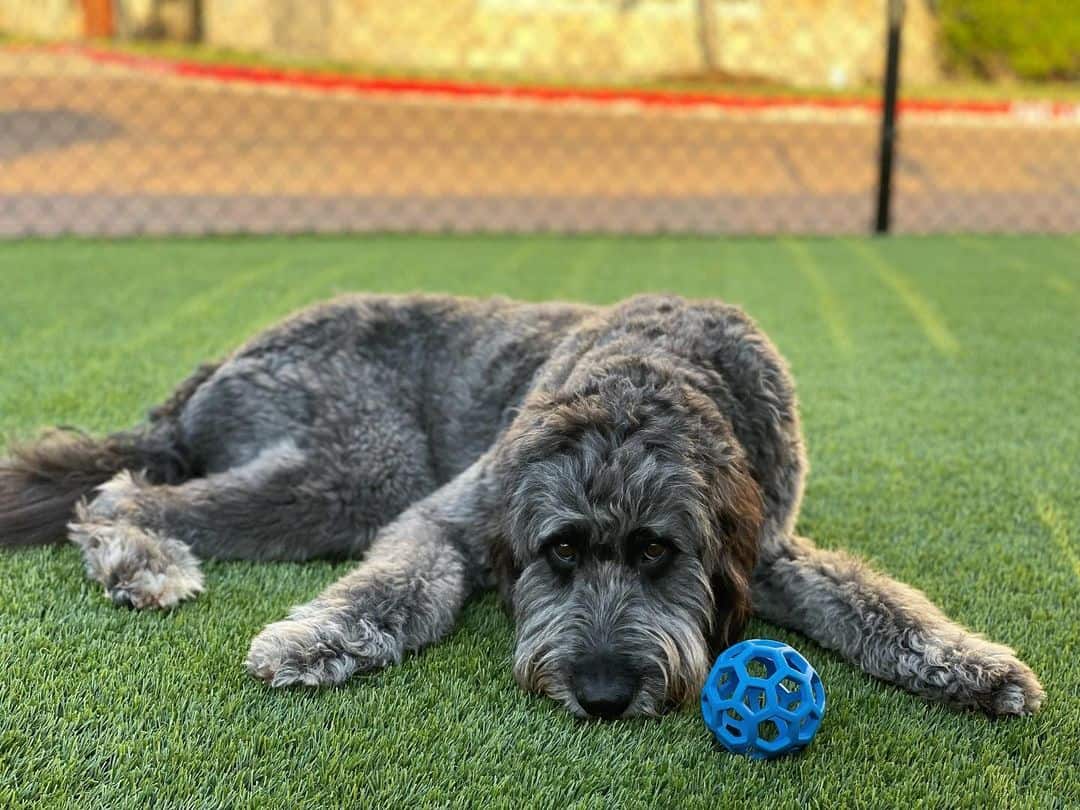
Photo from: @wolfeprincee
The caring and guarding personalities of Pyredoodles are frequently described by their owners. Although they are known to be generally shy with strangers, their massive magnitude simply makes them look frightening, which makes them good guards of the home. They are not at all aggressive though. They are actually quite composed, even-tempered dogs.
Although the Pyredoodle has a high level of intelligence, training can be challenging because of their tendency for stubbornness. The Poodle parent breed is amongst the 20 smartest dog breeds! Therefore, you can keep your dog interested and content throughout training sessions by using lots of positive reinforcement as well as praise-based training.
It is recommended to also give your Pyredoodle lots of mentally challenging toys or activities to keep them occupied and to stop any destructive habits starting to develop, especially while they are young! Also, the earlier the socialization, the better.
Early socialization is recommended with every dog breed, especially the ones that are on the larger side. This family pet is known to have hunting and guard dog blood in its veins, so it is highly important that you get this dog breed used to being around smaller animals from when it’s young.
These dogs typically thrive in residences with a garden and a backyard fence because of their big size. However, if given adequate activity during the day, they may adjust to living in apartments.
How Are Pyredoodles With Other Dogs?
You should know that these dogs have high energy levels. Therefore, they will need a lot of mental stimulation and daily exercise to maintain their physical and mental health.
Well, we can’t promise you that the Great Pyrenees Poodle mix won’t go crazy if it sees a cat or a squirrel in the dog park. That would definitely be a party. Hence, we are highlighting the need for early socialization and obedience training with positive reinforcement methods.
However, Pyredoodles are generally good around other dogs and won’t cause any problems. They are playful and could literally play catch for hours at the dog park.
If you get your dog used to being around smaller animals from a young age, you won’t have any problems when the dog grows into adulthood. Because trust me, it is easier to control a Pyredoodle puppy than a fully grown 100 pound dog.
Knowing all these things about the nature of this dog breed, you should look for some Great Pyrenees training tips, since the robust personality comes from the genes of this parent breed.
Are Pyredoodles Good Family Dogs?
As long as the dog receives lots of attention, the Pyredoodle adapts just as well to a family with kids as they do to one owner. Many allergy sufferers who desire a bigger breed dog, but simply cannot afford the shedding of a dog like the Great Pyrenees, turn to the Pyredoodle because of its distinctive, low-shedding coat.
Don’t be fooled if it looks like your Pyredoodle needs your constant attention. They like to be autonomous, and they are very driven to be free and to walk without the leash control of their owner. The good news is that they are trainable in many ways, and they will, if properly trained, always come back when you call their name.
They are highly curious, spontaneous, and very intelligent dogs, which will always make you and your family feel safe and loved. All of the family members will definitely enjoy spending time with this dog breed.
They are great with kids. If you have small children, you can leave your children to play with the Great Pyrenees Poodle mix without hesitation. Your kids could even pretend that this dog is their imaginary horse, and the Pyredoodle wouldn’t mind it, since they are very gentle with kids.
However, we recommend early socialization and early obedience training to prevent potential problems, because this is a highly intelligent, yet stubborn dog. They will need a lot of mental stimulation, daily walks, and exercise.
Dog parks and interactive dog toys are a great way of keeping them busy if you don’t have the time to go for an extra long walk. You can always consult other Dog owners of this dog breed, or owners of parent breeds of the Great Pyrenees Poodle mix, for some advice when it comes to its behavior.
Is The Great Pyrenees Poodle Mix A Healthy Dog Breed?
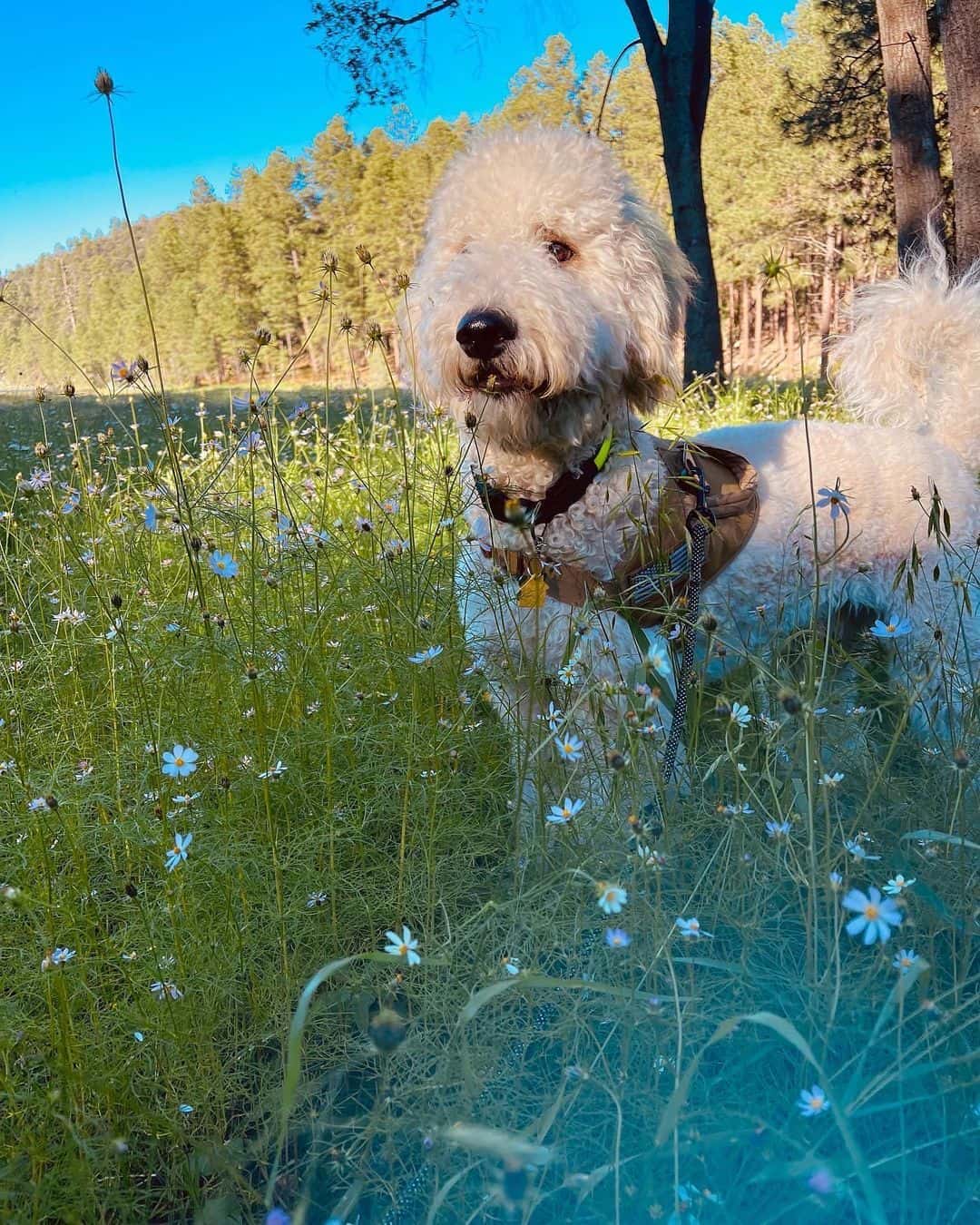
Photo from: @doodlecrazy
Some of the same ailments which affect the Great Pyrenees and the Poodle are bound to also affect the combined breed known as the Pyredoodle. While the majority are normally in good condition, a few may be predisposed to certain ailments, thus it’s crucial to maintain proper care and annual veterinarian examinations.
They generally are a healthy dog breed, but they have predispositions to some health issues, which can be both preventable and treatable.
Some of the health problems that the Pyredoodle can face are:
• Thyroid health problems: When the thyroid hormone is produced by your dog’s body in excess, it is called hyperthyroidism and your dog’s metabolism rises to hazardous levels. Although this illness affects dogs considerably less frequently than cats, it usually has significant consequences when it occurs.
Your holistic veterinarian could advise taking glandular or nutraceutical supplements. She might think about recommending iodine, selenium, or zinc supplements. All of these nutrients promote healthy thyroid function; Iodine is crucial for healthy thyroid function, and selenium and zinc assist in the conversion of T4 ( thyroxine) to T3 (Triiodothyronine).
• Luxation: The femur, or thighbone, and the tibia are joined at the knee joint (shinbone). Normally, the patellar (kneecap) is situated in a groove at the ends of the femur known as the trochlear groove. Luxating refers to an out-of-place or dislocated condition. A kneecap that “pops out” or shifts from its usual position is hence referred to as a luxating patella.
In dogs that have luxation, pet owners might notice their dog walking with a skip in her stride or running on three legs, but then she’ll abruptly return to using all four legs as if nothing had happened.
• Elbow dysplasia & Hip dysplasia: Hip dysplasia and elbow dysplasia both denote faulty joint conformation. All dogs with hip dysplasia will eventually develop osteoarthritis, which is characterized by discomfort and limited range of motion. Osteoarthritis management or joint replacement make up the majority of the treatment.
However, this health issue does not shorten your dog’s life, because it can be treated to a certain point, and it is not a malignant health problem.
• Bloating: GDV(Gastric dilatation and volvulus), often known as “bloat,” develops whenever a dog’s tummy twists after being filled with gas, food, or liquid. GDV can proceed swiftly and without prior notice. There is always a crisis.
A “simple bloat” or dilatation is the term used to describe stomach distension on its own. It’s possible for this minor bloating to develop and go away on its own. Bloat without twisting can still provide a life-threatening risk, but the degree to which, and length of time the dog has had the condition determine the risk. . When it doesn’t become life-threatening, it can sometimes just last for hours.
What Is The Best Dog Food For The Pyredoodle?
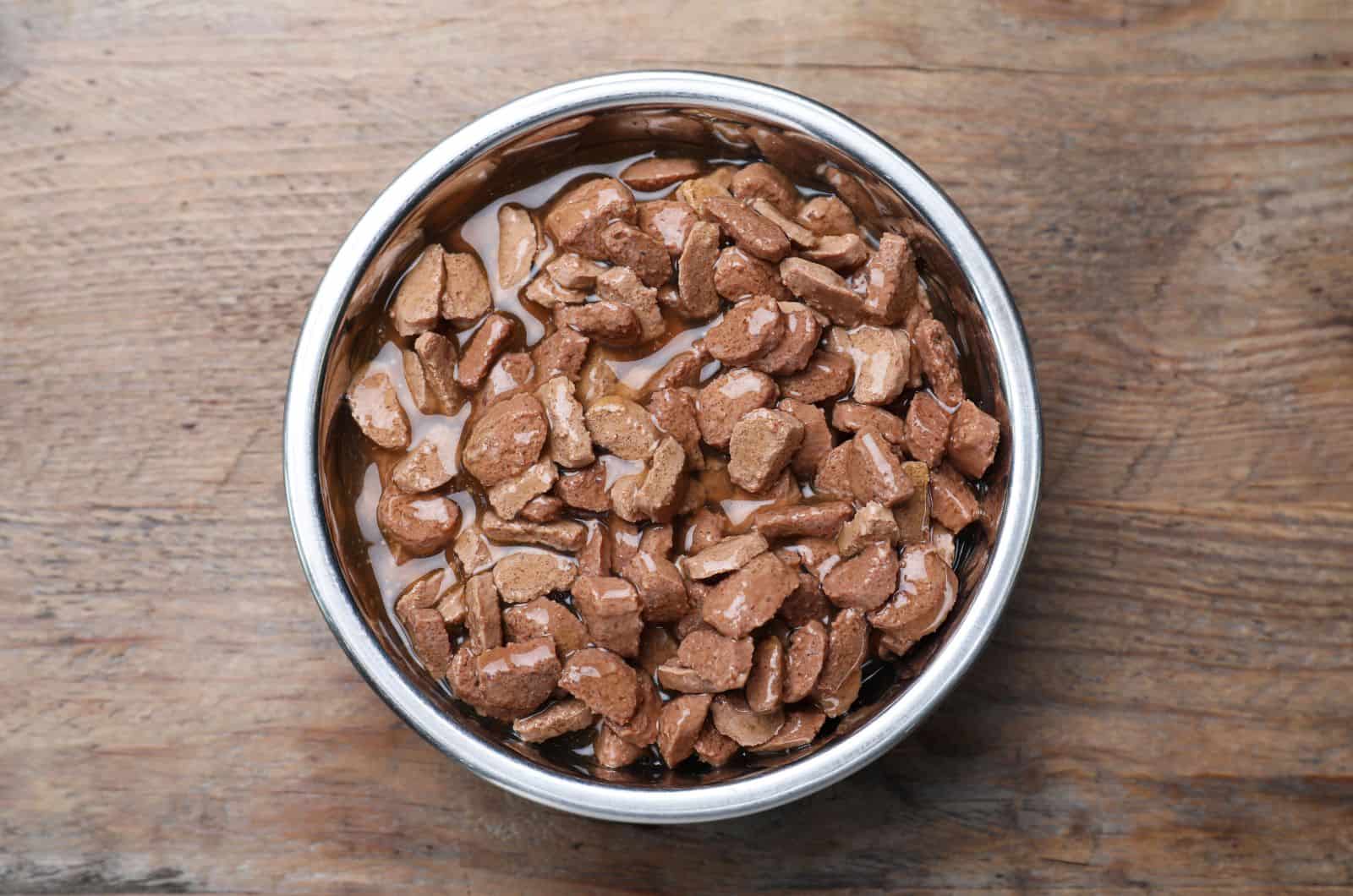
The anatomy of a dog’s stomach does not allow for the digestion and fermentation of carbs (the key ingredient in dog kibble). Even kibble made without grains frequently has a lot of beans, peas, and lentils, which are heavy in starchy carbohydrates.
This puts a dog’s system under stress, generating metabolically stressful surges in insulin, glucagon, and cortisol throughout the day. It also causes inflammation and stresses of important organs, which can, in some situations, result in a number of significant health concerns.
There is little doubt that this dog breed is adaptable, and despite consuming a diet that doesn’t include the natural ingredients they may also need, dogs should be ok for a while. But there is a huge difference between getting by and thriving.
The best dog food for any dog breed would be a raw diet with some supplements, or extremely good dog food. Dry kibble just isn’t enough for any dog breed, since most of them don’t include all the valuable nutrients for a puppy’s growth or to maintain an adult’s health.
This dog breed needs around 1 1/2 to 2 pounds of dog food daily. If you decide to implement a raw diet, it is good to make well balanced meals by including bones, muscles, and organ meat such as heart, liver, tripe, etc. You also need to provide healthy fibers by introducing vegetables such as pumpkin.
What Is The Lifespan Of The Pyredoodle?
Bearing in mind that large dog breeds live shorter than smaller dog breeds, the life expectancy of the Great Pyrenees Poodle mix is accordingly so.
They have an average life expectancy ranging from 10 to 12 years. However, if you go for regular vet checks and maintain your dog’s health, your dog can live longer than that.
Good quality dog foods and supplements also play a big role when it comes to the life expectancy of your canine friend. Maintaining good gut health with a balanced diet and keeping your dog active are great ways to keep them both mentally and physically healthy.
The aberrant cell proliferation associated with cancer may be more common in large breeds than in small breeds because of their higher rate of growth. Or, since they mature so quickly, huge dogs may experience ailments associated with old age earlier.
However, even though the parent breed – the Great Pyrenees is a large dog breed, it is known to live longer than another large dog breed, the Great Dane. It has to do with genes and the way health problems develop and progress within the immune system of each different dog breed.
Do Pyredoodles Shed?
The Pyredoodle has a genetic history that makes it a low shedder. According to the dominant Parent breed whose genes they inherited the most of, they get a shorter or longer coat. Whatever the case, they do have a double coat.
The ones with shorter, wavy, medium-length coats are like Standard Poodles, while those with longer, thicker coats resemble Great Pyrenees.
The Standard Poodle fur predominates and doesn’t shed at all, which is wonderful news for Pyredoodle owners. Those who have allergies will love this feature.
As this dog is considered a hypoallergenic dog, you won’t have any problems with coughing, sneezing, or a runny/stuffy nose. The Poodle has many reasons to be considered a hypoallergenic dog breed, and this poodle mix has obtained the good poodle genes in that sense.
Even though your dog doesn’t shed much, frequent brushing is still necessary to keep him from matting. To remove the tangles that form while they are puppies, use a comb.
Additionally, you can visit a groomer for your Pyredoodle every six to eight weeks. Regular grooming helps prevent any matting, skin allergies, or any kind of skin health issues.
Bathing your pet should only be done when absolutely required. Numerous bathing sessions affect the natural oils of the hairs.
You should clean your dog’s teeth on a regular basis, roughly three times per week, in addition to grooming their coat. Also, keep your hygiene up by occasionally trimming your dog’s nails.
Does The American Kennel Club (AKC) Approve Of The Pyredoodle?
Both of the parent dogs of this cross breed dog breed were approved by the American kennel club a long time ago.
The Great Pyrenees mountain dog was approved and made an official dog breed almost 100 years ago, in 1933.
Whereas the standard Poodle, or the Poodle, was recognised as an official dog breed all the way back in the late 19th century, in approximately 1887.
Both of the parent breeds of the great Pyrenees poodle mix are famous dog breeds for winning dog show competitions all the time. Therefore, we can conclude that making this crossbreed was an ambitious move by breeders, when we consider the great origins of both of the parent breeds.
However, the great Pyrenees poodle mix is still not a breed which is approved by the American kennel club (AKC). Crossbreeds in general have a hard time being approved as an official dog breed. Actually, any dog breed that has been made recently, has verification problems.
How Much Does the Pyredoodle Cost?
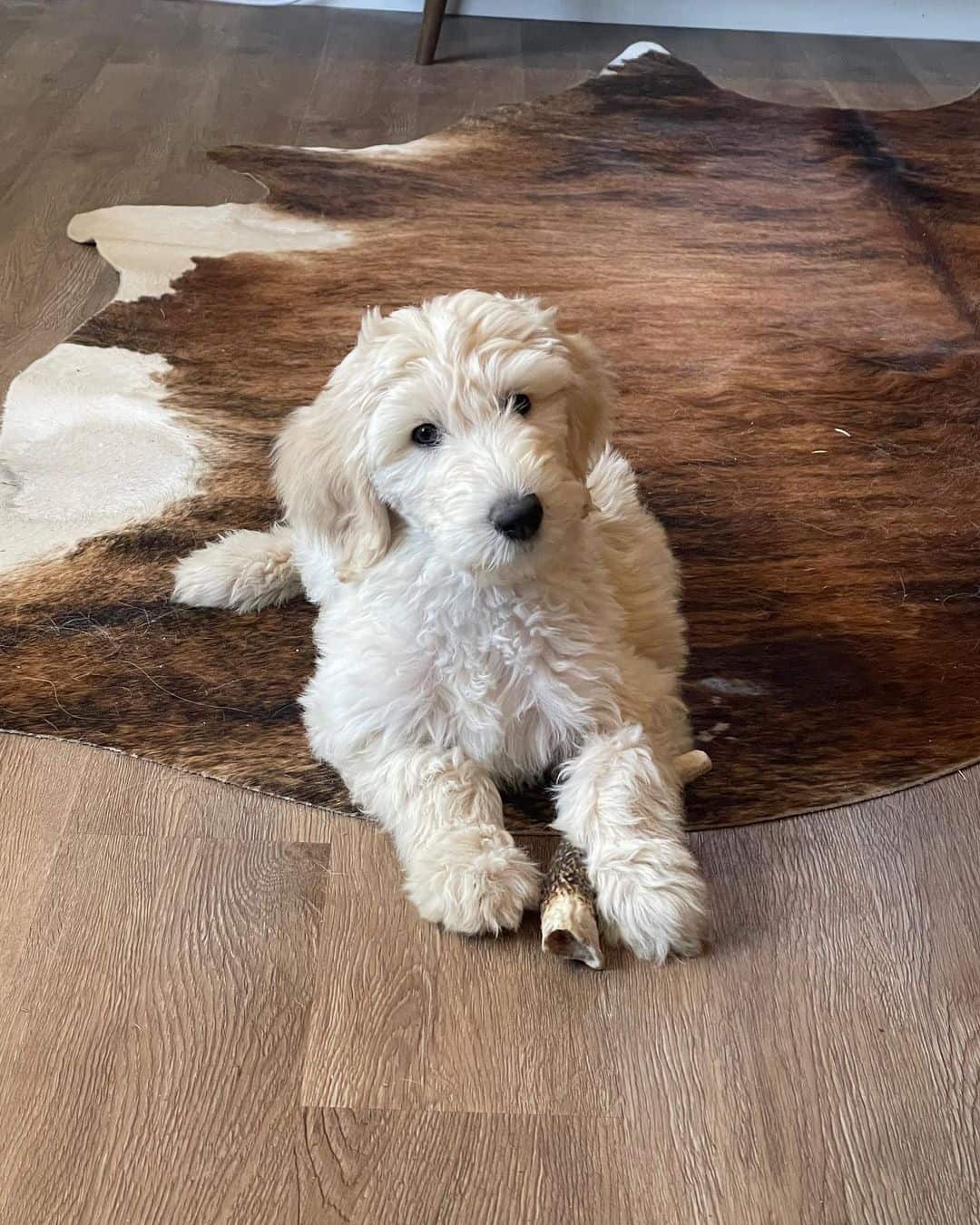
Photo from: @doodlecrazy
Prices can vary from breeder to breeder. However, you need to make sure that you are buying from a reputable breeder, that isn’t using the puppies’ parent dogs as puppy mills.
The price of the great Pyrenees poodle mix can be anywhere from $1000 all the way to $4000. This largely depends on the pedigree of the dog, the parents of the dog, and the grandparents of the dog.
If one of the parent breeds is from a highly known breeder, or if it’s a dog show winner, you can easily expect that the price range for your Great Pyrenees poodle mix puppy will go up to even above the $7000.
However, there are some breeders that will mix a Great Pyrenees mountain dog or a standard Poodle with the great Pyrenees Poodle mix, in order to have more of the looks or the personalities of one of the parent dog breeds.
Adoption Of The Pyredoodle Dog
Sadly, many dogs of all breeds end up in dog shelters. That is mostly because people buy a little curly, furry puppy that grows up to be a larger dog breed than they expect it to be.
Every dog breed is cute, adorable, and interesting to play with when it’s a puppy. There are many irresponsible dog owners who drop off their dogs to the local shelter when they cannot provide for them anymore.
Luckily dog shelters do exist, and good people can provide a forever home for those lost and sad pups. If there is a local shelter near the place where you live, please reach out to them or visit the dog shelter yourself before deciding to buy The Pyredoodle.
Many of the large dog breeds, including the Great Pyrenees Poodle mix, end up in places like shelters , because they grow to be bigger than the dog owners expect. . If you have the tiniest thought that you might be able to adopt a dog breed, we wholeheartedly support you to do so.
There are many reasons to adopt a dog from a shelter. Dogs that have been adopted will forever be grateful to you and will show you a special kind of love and gratitude that you will be amazed by. They will see you as their saviours, and they will be extremely loyal and protective of you because that’s how they show their gratitude. .
They may be sad at the beginning and display that sadness by crying or barking, but when they get to understand that they have a new family, who treats them well, they will be the happiest dogs out there.
Short List Of Pros And Cons Of Owning A Pyredoodle
There are many good sides to owning this dog breed. However, there are a few downsides, which are almost unnoticeable in comparison to their good sides.
However, we have made the shortest and most concise list of a few good and bad sides to which you should pay attention if you are interested in buying a Great Pyrenees Poodle Mix Puppy.
Pros:
• Great guard dog / watch dog
• Excellent Family pet
• Hypoallergenic / low shedding
Cons:
• Needs professional grooming (which can often be expensive) and daily brushing to prevent matting
• Are usually stubborn if not trained when they are young
• Large dog breed equals big appetite. Conclude for yourself!
So, Is The Pyredoodle For You?
Any dog owner, whether a full household or a single person, can find a Pyredoodle to be the ideal pet. But just like with most animals, your Pyredoodle will need some of your time and attention. To keep it mentally and physically stimulated, you must take it for daily walks and keep it busy with a variety of activities throughout the day. .
Don’t forget to engage them in a variety of activities, particularly those that take place outside, as they tend to get disruptive when kept inside for an extended period of time. Give your pups puzzles and toys that will assist stimulate their minds even while they are within the house.
Due to both of its parents being intelligent, the Pyredoodle is an extraordinarily clever dog breed. They make excellent therapy dogs and nanny dogs.
It interacts effectively with dog owners thanks to its kind personality. Although easy to teach, it must begin training at a young age. This is because training the Pyredoodle pups, who have not yet developed bad behaviors, is considerably simpler than training an older dog.
To avoid being too timid to engage with other dogs, a Pyredoodle puppy needs to be socialized at the appropriate age. However, a well socialized and taught Pyredoodle will feel comfortable interacting with both people and other animals.
This is a great guard dog which will make you and/or your family feel safe. They are a great option for a family pet, since they are dogs who love to be around people and always want to have someone with whom they can interact.
This may not be the best dog breed for the first time owners, however, this is a great option for a lively family or an individual that leads a healthy, active lifestyle.
Read Next: The Great Pyrenees Newfoundland Mix: Gentle Giants 101
